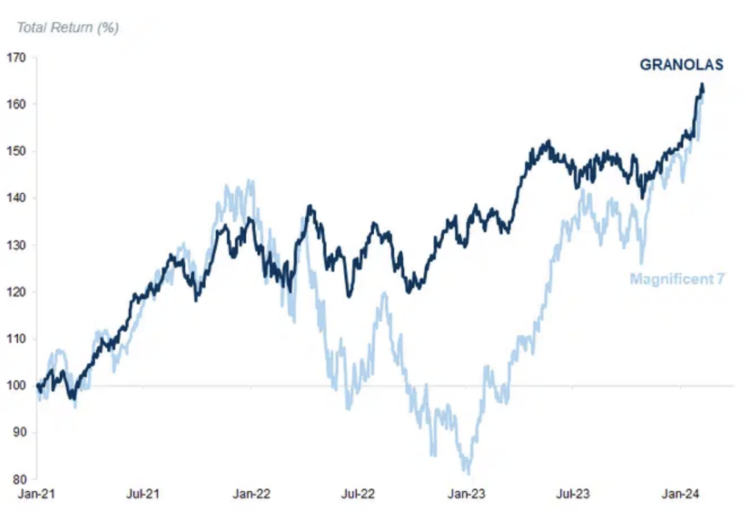Since early in 2023, stock market gains have been led by a small subset of companies. These firms are known collectively as “The Magnificent Seven.”
|
|
|
|
|
|
|
There are a number of reasons these companies have done well, but one of the biggest is the excitement around artificial intelligence (AI). From virtually nowhere, AI has jumped to the forefront of the collective consciousness, as evidenced by the chart below:
ChatGPT Adoption Significantly Quicker than Previous Technological Advances (Time to 100 Million Users, Months)

The excitement around AI has in turn driven revenue growth, both realized and anticipated, for many of the Magnificent Seven. But perhaps the biggest winner has been Nvidia. As you can see in the chart below, Nvidia’s data center growth, which is focused on AI, has soared nearly 5x in the last year.
Nvidia’s Revenue has Skyrocketed

Another view of Nvidia’s revenue growth can be seen in the chart below top, demonstrating the sharp increase in revenue. However, it’s important to also note the chart below bottom, which shows the surge in Nvidia’s stock price. That move, which is of a magnitude even greater than the company’s revenue growth, has propelled the company’s value to truly lofty heights.
Nvidia’s Revenue and Stock Price Both Surge

 Note: Data as of February 16, 2024; Source: YCharts.
Note: Data as of February 16, 2024; Source: YCharts. In fact, Nvidia recently became the fourth most valuable company in the world, trailing only Microsoft and Apple in the United States and Saudi Aramco overseas.
Market Capitalizations of the Magnificent Seven

As you might expect, recent stock market performance of the Magnificent Seven has been strong, though its important to note that in 2022, these stocks were among the worst performers. Nevertheless, strong gains since early 2023 have propelled these companies, and the broader markets, higher.
Stock Market Performance of the Magnificent 7

That summary brings us to the topic at hand, namely: can these tech giants continue their incredible run? Well, the truth is, I don’t know. On the positive side, these are great companies, growing quickly, and in many cases generating huge profits. On the other hand, the same thing could have been said in 1917 or 1967 about any of the companies in the chart below. Corporate titans such as U.S. Steel, Bethleham Steel, Sears Roebuck, or Polaroid were once held in the same reverence that investors today hold Apple or Microsoft. Times change, and the annals of history are littered with companies that no longer exist. And even among those that still remain, only a rare few have retained a seat at the very pinnacle of corporate America for much more than a couple decades.
America’s Biggest Companies: 1917, 1967, 2017

It is also important to note that focusing too heavily on a small subset of stocks can result in missed opportunities elsewhere. For example, let’s look to poor, beaten down Europe, which is hindered by an aging population, the war in Ukraine, and tepid economic growth. But, consider a subset of eleven companies, popularly dubbed the “GRANOLAS.” These eleven companies comprise a wider array of sectors than the Magnificent Seven, providing an investor with greater diversification. They also sport a higher dividend yield, and are less expensive on a forward P/E basis.
Europe’s GRANOLAS Compare Favorably to the Magnificent 7

 Source: EuroNews-Business, Who are the GRANOLAS? A Look at Europe’s ‘Magnificent Eleven’ Stocks, February 2024
Source: EuroNews-Business, Who are the GRANOLAS? A Look at Europe’s ‘Magnificent Eleven’ Stocks, February 2024 And here’s the kicker; since 2021 the GRANOLAS have provided the same return as the Magnificent Seven, but with a lot smoother ride.
Less Volatility, Similar Returns

The bottom line is that there is no reason to ignore or avoid investing in the Magnificent Seven. In fact, here at Pure Financial Advisors, those companies constitute some of the largest holdings in many of our portfolios. But there are at least two arguments against overfocus in any handful of stocks. The first is that history has shown time and time again that as society changes, so too does America’s pre-eminent corporations. Furthermore, market leadership tends to rotate, and to use a simple analogy, trees don’t grow to the sky. The second reason is that markets in the U.S. as well as around the globe offer a plethora of opportunities to find and invest in dynamic, successful companies. To ignore those possibilities and concentrate in a handful of stocks not only might sacrifice significant returns, it also increases portfolio risk.
Next Steps:
• Review your account(s) to determine if you have an appropriate level of diversification across asset classes, sectors, company sizes, company valuations, and geographies.
• Calculate your Required Rate of Return to see if your portfolio is likely to produce the results you require with a manageable level of risk.
• Take a deeper dive into your overall financial situation using our free EASI Retirement.











